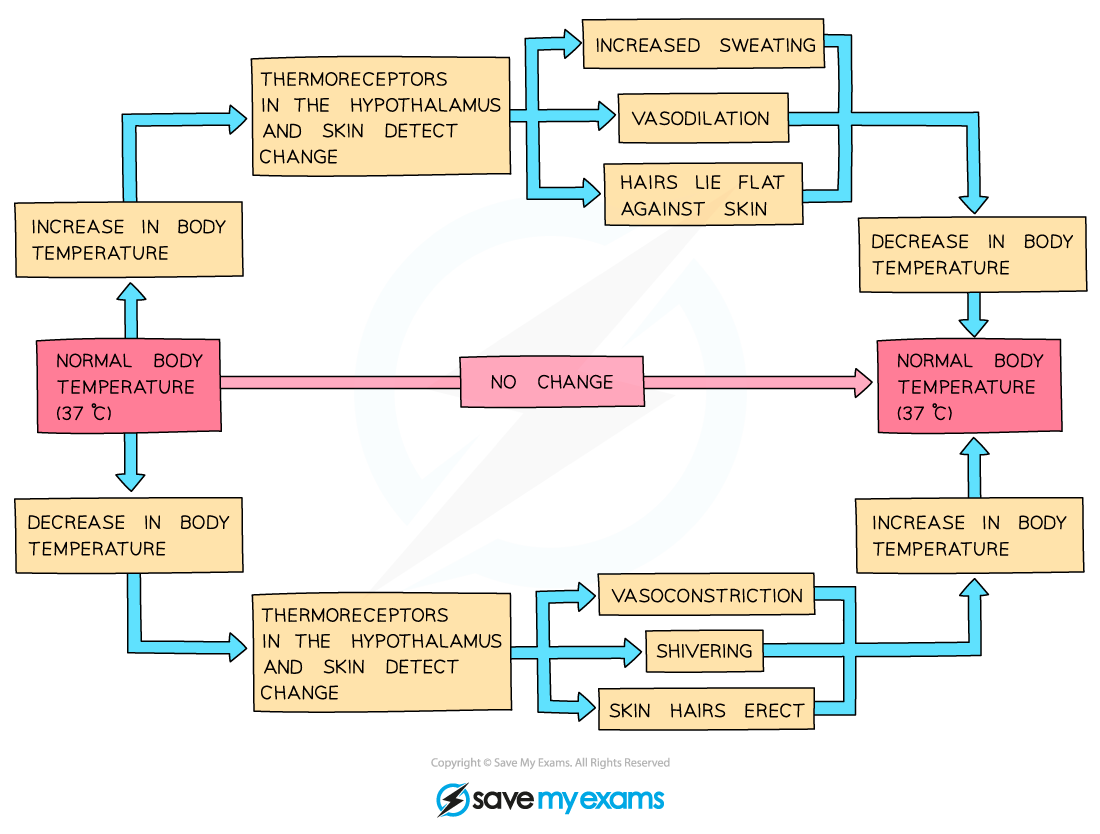Thermoregulation (OCR A Level Biology) : Revision Note
Thermoregulation in ectotherms & endotherms
Homeostatic mechanisms help organisms to keep their internal body conditions within restricted limits
Temperature is a key factor that needs to be controlled; the human body maintains a core temperature of around 37.5 °C
A stable core temperature is vital for enzyme activity
Lower temperatures reduce the kinetic energy available for molecules and slow down chemical reactions
Higher temperatures speed up reactions up to a point, above which the rate of reaction drops sharply as the enzyme begins to denature
Thermoregulation
Thermoregulation is the control of internal body temperature
Animals can be split into two groups on the basis of their primary thermoregulation mechanism:
Endotherms
animals that possess physiological mechanisms for the maintenance of internal body temperature
e.g. mammals and birds
Ectotherms
animals that rely on behavioural mechanisms to ensure to maintain internal body temperature, e.g. by moving into or out of the sun, or huddling together for warmth
e.g. reptiles and amphibians
Thermoregulation in endotherms
Endothermic animals detect external temperatures via peripheral receptors; these are thermoreceptors found in the skin and mucous membranes
Receptors detect heat and cold
Impulses are sent from the receptors to the hypothalamus
The hypothalamus also contains receptors that monitor the temperature of the blood flowing through it
Information from the receptors is processed by the hypothalamus, which then initiates homeostatic responses when temperature gets too high or too low
Human skin contains a variety of structures that are involved in the regulation of heat loss

Human skin contains several structures that are involved with thermoregulation
Endotherm responses to high body temperature
Vasodilation
During vasodilation the muscles in the walls of arterioles relax, causing dilation and allowing more blood to flow into skin capillaries
Heat is lost to the environment by radiation
Sweating
Sweat is secreted by sweat glands in the skin
This cools the skin by evaporation
Heat energy from the body is used to convert liquid water into water vapour
Sweating is less effective as a cooling mechanism in humid environments there is a reduced water vapour concentration gradient between the skin and the air when humidity is high
Flattening of hairs
The hair erector muscles in the skin relax, causing hairs to lie flat
This stops them from forming an insulating layer of air and instead allows air to circulate over skin, removing heat lost by radiation

Effectors that aid heat loss from the skin include muscles in the arteriole walls, sweat glands and hair erector muscles
Endotherm responses to low body temperature
Vasoconstriction
During vasoconstriction the muscles in arteriole walls contract, causing the arterioles near the skin to constrict and allowing less blood to flow through skin capillaries
Instead, the blood is diverted through shunt vessels, which are deeper in the skin and therefore do not lose heat to the environment
Heat loss by radiation at the skin surface is reduced
Increased metabolic rate
Most of the metabolic reactions in the body are exothermic and this provides warmth to the body
In cold environments the hormone thyroxine increases the basal metabolic rate (BMR), increasing heat production in the body
Thyroxine is released by the thyroid gland
Shivering
Muscles contract and relax repeatedly in quick succession
The metabolic reactions required to power this muscle contraction releases heat energy to warm the blood and raise the core body temperature
Erection of hairs
The hair erector muscles in the skin contract, causing hairs to stand on end
This traps an insulating layer of air over the skin's surface, reducing heat loss by radiation

Effectors that respond to low body temperature include the muscles in arteriole walls, the thyroid gland, the muscles that cause shivering and the hair erector muscles
Body temperature control table


Temperature control is an example of negative feedback
Thermoregulation in ectotherms
On land environmental temperatures can vary greatly between seasons, or even during a single day
Ectotherms do not have the ability to respond to these changes via internal temperature regulation mechanisms, so they instead use behavioural mechanisms:
To warm up ectotherms may:
seek out the sun or warmer surfaces and 'bask' in these locations as they warm until their body temperature has been increased sufficiently
huddle together to retain heat that may have been gained from the sun earlier in the day
To cool down ectotherms may:
seek shade
move their bodies into water
The behaviour of ectotherms is restricted by environmental temperatures, meaning that they cannot easily colonise habitats that are very hot or cold
Ectotherms save a lot of energy by not regulating their body temperature internally, so their nutritional requirements may be much lower; ectotherms can survive in environments where food is limited
Aquatic ectotherms have little difficulty maintaining a stable internal body temperature as water temperatures are significantly less variable than those on land
This is due to the high specific heat capacity of water)
Examiner Tips and Tricks
Remember that vasodilation and vasoconstriction are caused by the relaxing and contracting of muscles in the arterioles, not the capillaries; capillaries do not have muscles in their walls.

You've read 0 of your 5 free revision notes this week
Unlock more, it's free!
Did this page help you?
